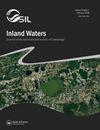Macrophyte growth forms shift along the trophic gradient of lakes
IF 2.3
3区 环境科学与生态学
Q1 LIMNOLOGY
引用次数: 0
Abstract
Abstract:Phototrophic organisms in lakes change from macrophyte to phytoplankton dominated states along trophic gradients. Before lakes reach a turbid and phytoplankton dominated state, shifts from meadow-forming Characeae to canopy-forming macrophyte species can occur, where Characea are present (i.e. especially in oligo to mesotrophic lakes with sand or gravel substrate). However, eutrophication intensity causing this shift has not yet been estimated.We analysed data from 132 lakes located in Mecklenburg-Vorpommern (Germany). With a Generalized Linear Model (GLM) and Random Forest (RF) models complemented with grid approximation, we analysed (i) if species richness of macrophytes declines along eutrophication gradients, (ii) above which chlorophyll-a concentrations the abundance of Characeae declines, and (iii) above which chlorophyll-a concentrations the abundance canopy-forming species declines.The number of macrophyte taxa declined gradually following a log-linear trend and with increasing chlorophyll-a concentrations. Based on the RF models, the abundance of Characeae already decreased at 5-13 µg L-1 chlorophyll-a, whereas canopy-forming species showed a monotonous and slight unimodal response decreasing at 35-103 µg L-1 chlorophyll-a.The results support the theory of shifts in growth forms along eutrophication gradients in lakes and provides, for the first time, estimations of chlorophyll-a concentrations required for these shifts. Changes in growth forms are obvious indicators for eutrophication and can serve as an additional incentive to improve lake trophic status.Keywords: aquatic plantscanopy forming macrophytesCharaceaechlorophyll-aDisclaimerAs a service to authors and researchers we are providing this version of an accepted manuscript (AM). Copyediting, typesetting, and review of the resulting proofs will be undertaken on this manuscript before final publication of the Version of Record (VoR). During production and pre-press, errors may be discovered which could affect the content, and all legal disclaimers that apply to the journal relate to these versions also. AcknowledgementsWe would like to thank the Ministry of Agriculture and the Environment of the federal state of Mecklenburg-Vorpommern for kindly providing the macrophyte and water quality data of the lakes in Mecklenburg-Vorpommern. This study was partly conducted within the AQUATAG project, funded by the German Federal Ministry of Education and Research, grant number 033W046C. Willem Kaijser and Daniel Hering were partly supported by the Collaborative Research Centre 1439 RESIST (Multilevel Response to Stressor Increase and Decrease in Stream Ecosystems; www.sfb-resist.de) funded by the Deutsche Forschungsgemeinschaft (DFG, German Research Foundation; CRC 1439/1, project number: 426547801). The authors declare no conflict of interests.Data availability statementData are available from the respective authority upon reasonable request.大型植物的生长形式沿着湖泊的营养梯度变化
摘要/ Abstract摘要:湖泊光养生物沿营养梯度由以大型植物为主向以浮游植物为主转变。在湖泊达到浑浊和浮游植物为主的状态之前,从草甸形成的特征到树冠形成的大型植物物种的转变可能发生在特征存在的地方(即特别是在具有沙子或砾石基质的寡营养型湖泊到中营养型湖泊)。然而,引起这种转变的富营养化强度尚未得到估计。我们分析了位于梅克伦堡-前波莫瑞(德国)的132个湖泊的数据。利用广义线性模型(GLM)和随机森林(RF)模型与网格近似相结合,我们分析了:(1)大型植物物种丰富度是否沿着富营养化梯度下降,(2)叶绿素-a浓度高于富营养化梯度,特征丰度下降,(3)叶绿素-a浓度高于富营养化梯度,树冠形成物种丰度下降。随着叶绿素-a浓度的增加,植物类群数量呈对数线性递减趋势。基于RF模型,在5-13µg L-1叶绿素-a时,特征物种的丰度已经下降,而在35-103µg L-1叶绿素-a时,冠层形成物种的丰度表现出单调和轻微的单峰响应。研究结果支持了湖泊富营养化梯度中生长形式变化的理论,并首次提供了这些变化所需的叶绿素-a浓度的估计。生长形式的变化是富营养化的明显指标,可以作为改善湖泊营养状况的额外激励。关键词:水生植物;扫描形成大型植物;特征;叶绿素;免责声明作为对作者和研究人员的服务,我们提供这个版本的接受稿件(AM)。在最终出版版本记录(VoR)之前,将对该手稿进行编辑、排版和审查。在制作和印前,可能会发现可能影响内容的错误,所有适用于期刊的法律免责声明也与这些版本有关。我们要感谢联邦梅克伦堡-前波莫瑞州农业和环境部提供梅克伦堡-前波莫瑞州湖泊的大型植物和水质数据。这项研究部分是在AQUATAG项目中进行的,该项目由德国联邦教育和研究部资助,资助号为033W046C。william Kaijser和Daniel Hering得到了1439 RESIST(溪流生态系统对压力源增加和减少的多层次响应)合作研究中心的部分支持;www.sfb-resist.de)由德国研究基金会(DFG,德国研究基金会;CRC 1439/1项目编号:426547801)。作者声明没有利益冲突。数据可用性声明应合理要求,可从有关当局获得数据。
本文章由计算机程序翻译,如有差异,请以英文原文为准。
求助全文
约1分钟内获得全文
求助全文
来源期刊

Inland Waters
LIMNOLOGY-MARINE & FRESHWATER BIOLOGY
CiteScore
6.10
自引率
9.70%
发文量
34
审稿时长
>12 weeks
期刊介绍:
Inland Waters is the peer-reviewed, scholarly outlet for original papers that advance science within the framework of the International Society of Limnology (SIL). The journal promotes understanding of inland aquatic ecosystems and their management. Subject matter parallels the content of SIL Congresses, and submissions based on presentations are encouraged.
All aspects of physical, chemical, and biological limnology are appropriate, as are papers on applied and regional limnology. The journal also aims to publish articles resulting from plenary lectures presented at SIL Congresses and occasional synthesis articles, as well as issues dedicated to a particular theme, specific water body, or aquatic ecosystem in a geographical area. Publication in the journal is not restricted to SIL members.
 求助内容:
求助内容: 应助结果提醒方式:
应助结果提醒方式:


